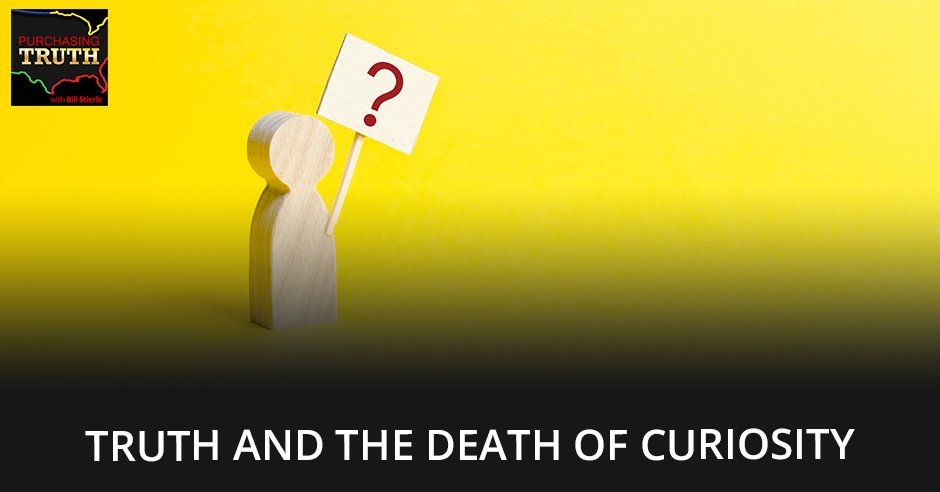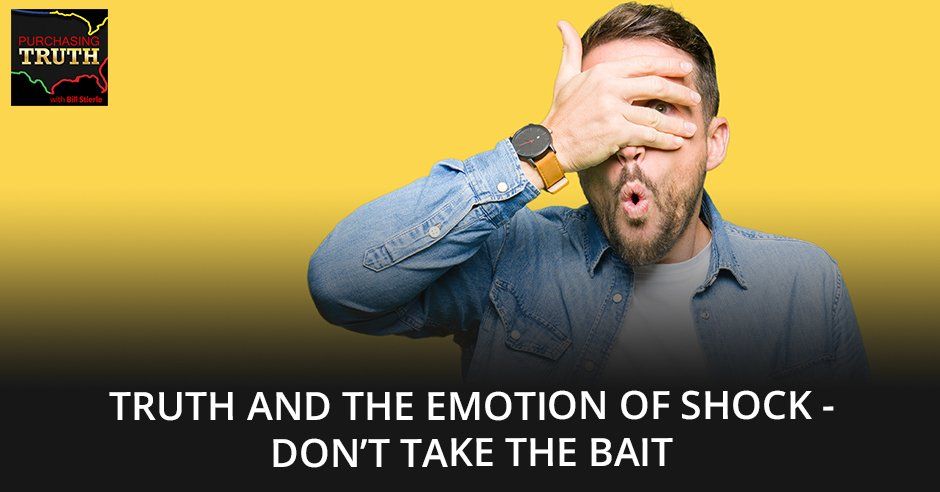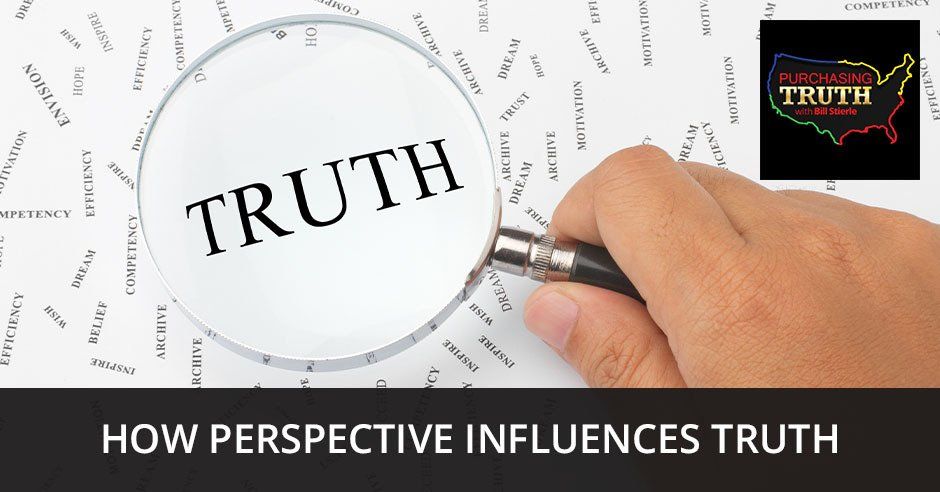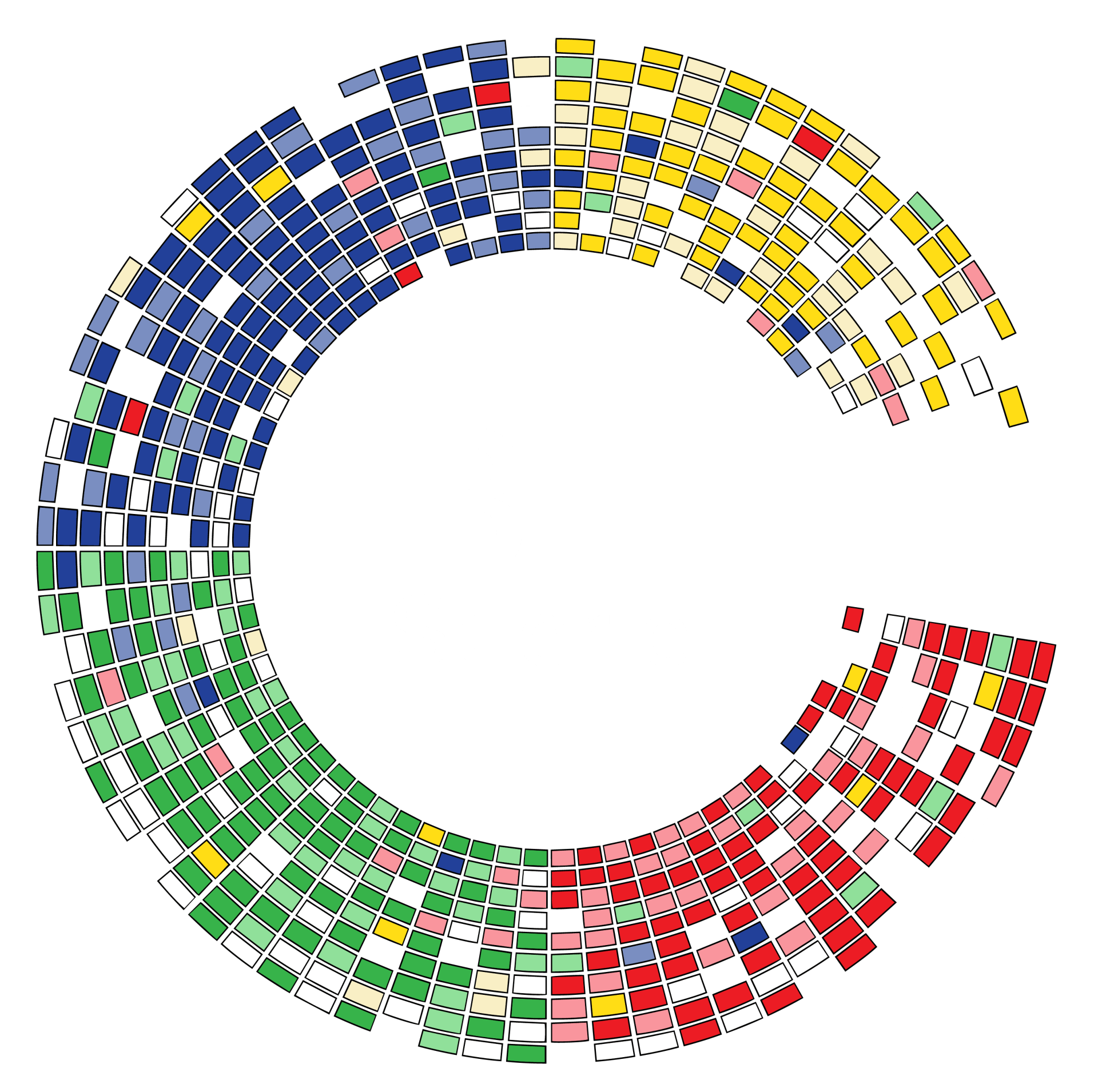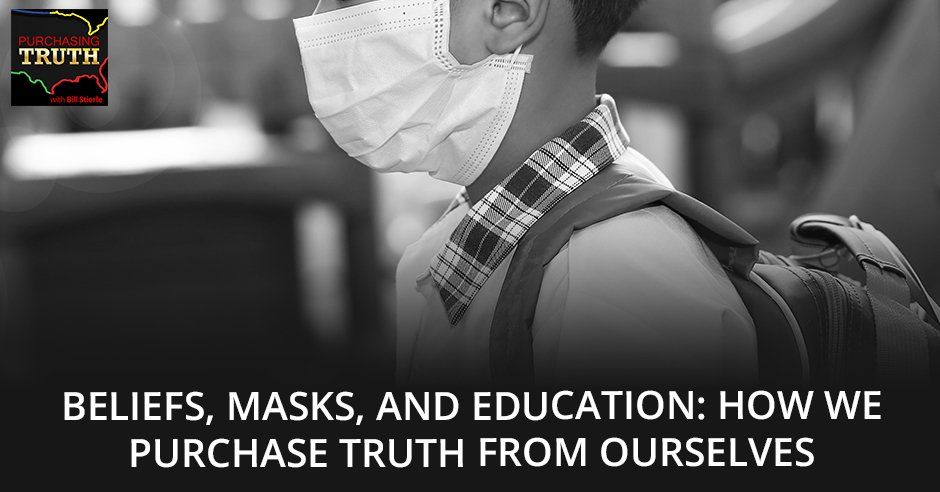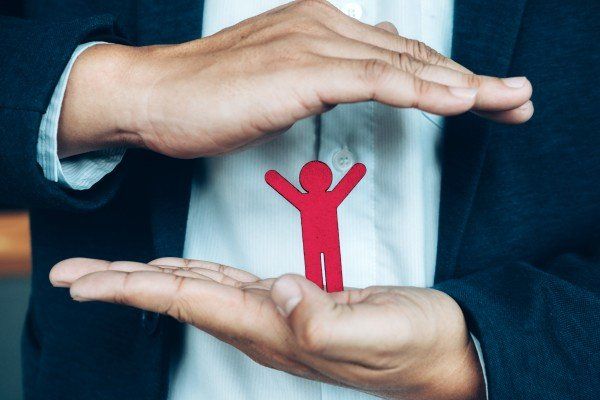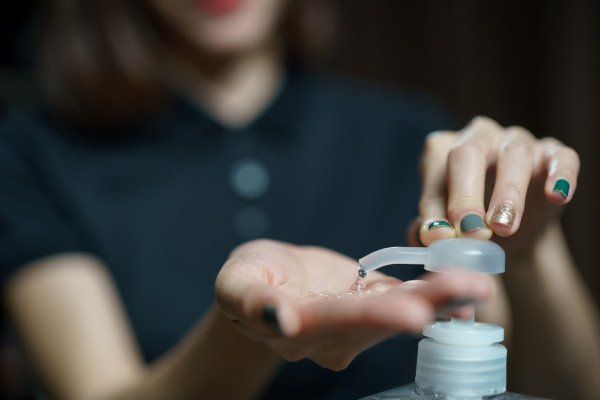Beliefs, Masks, And Education: How We Purchase Truth From Ourselves
Subscribe Today!
Little do we realize it, but our beliefs have the power to purchase truth from us. No matter what others say, if we are already bought into what we believe, it can be very difficult to see anything else. In this episode, Bill Stierle and Tom talk about how our beliefs shape the truth, especially in the context of the current situation of our children’s education. The on-going talks of school reopening have undeniably brought to the surface differing views about wearing masks, social distancing, and overall safety in this COVID-19 world. Join Bill and Tom as they reflect on the many implications of this situation, reminding us of understanding how our rights should never be at the expense of others.
---
Watch the episode here
Bill, we left off last time teasing that we would talk about beliefs and how they can purchase truth from ourselves. We’ve had an interesting experience here in Southern California, especially in my city. It’s a great jumping point for this discussion. I live in Orange County, California and the Board of Education in Orange County voted that the children would return to school on time this fall. Meaning the schools would open and they were not going to require teachers or students to wear masks. That was a bit of a shocking, somewhat unexpected vote, especially after the County of Los Angeles and the County of San Diego both said that schools are not opening. It’s going to be entirely distance learning this fall. Orange County, which tends to be more conservative went a different way.
My wife and I are parents in this district. We have two children in elementary school and we are wondering what’s going to happen. The school district for our city, which has 36,000 students, we have a population of about 250,000 in our city, said that schools are going to open but each district can make their own rules. What they’ve done here is they’re saying all students and teachers will wear masks on school properties at all times. However, they have offered three options for parents to choose and it’s interesting. Our children can either go back to school full-time, five days a week. There are all-new protocols and practices about wearing masks, how many students are in class, and proper social distancing.
The second option is you have what they’re calling a hybrid model, where your child would be in school two days a week. It’s either going to be Monday, Thursday or Tuesday. Friday with Wednesday, none of these students would be in school. You’re in school two days a week and then virtual learning or distance learning the other three days of the week. The third option is completely virtual learning and not in school at all. There are lots of interesting things around this. If it’s virtual learning, they told us you may not have a teacher for your child that’s from your local elementary school. It might be a teacher from a different place in the district, but because they’re virtual, it doesn’t need to be from your school. They’re pooling all these virtual learners together differently. My wife and I are trying to study, read up and absorb as much information as possible to make the best decision for our children.
What I realized as we’re doing that is our own beliefs are playing a significant role. It has to because while I think the district is doing a good job of doing their best to try to provide certainty around safety, learning, protection and all these things, they have not provided us enough information to have certainty around this. We have to fall back on our own beliefs and make our own decision. I have issues with my child wearing a mask all day long, five days a week. I have a belief that no matter what type of mask it is, you’re going to be breathing in a lot more of your own exhaust, carbon dioxide, or your own breath. I don’t think that’s a healthy thing for a growing brain, but that’s a belief of mine. I’m not a scientist.
That’s the hard part about this when you get a belief that runs the show or a series of beliefs. It’s like that old picture of the devil on one shoulder or the angel on the other shoulder. They start arguing with each other because beliefs do that, “Should I do this? What about this if I do that? If I do this, I go to hell. If I do this, I go to heaven.” You’ve got the argument that takes place. What has taken place in order to purchase truth is the pollution of the feeling of doubt or skepticism. The quickest way to take out a fact is to put doubt and skepticism around the fact. It’s a hard thing to talk about because then we were up to ourselves. We become a divided person because you get two thoughts on one side. If you are able to rest on a certain need that’s going to serve you, then what winds up happening is the decision becomes a lot easier. You asked yourself the question, “If my kid got COVID and I could have prevented it, am I meeting my fundamental need for protection and safety for my kid as a parent?” That answer is no.
I have a serious fear of that. We mentioned last time that we had a friend, a colleague who died of COVID-19 because his child got it outside and brought it home. He was a high-risk individual. I have competing beliefs here because I believe my child is not going to get as good an education learning from home. I believe the distance learning is too new. It’s unproven. I don’t think they’ve had enough practice doing it to know what works effectively. I have this belief that my child is not going to get as good an education learning at home as opposed to being in school. However, I also have this belief/concern because my wife had pneumonia once in her past.
Once you had pneumonia, you’re more likely to get it again and your lungs are somewhat compromised. If I send my child to school to get a better education or what I believe will be better education in person, I’m now worried about my child seriously ill from COVID. I do worry that she’ll bring it home to my wife and then that would be a dangerous situation. I’m talking about competing beliefs and trying to know what to do here.
The need for safety and protection, all we’ve got to do is play it out a little bit. All the person has to do it. The person that says no masks and the good need that they’re trying to get met, freedom, independence and choice. We don’t want the government forcing us to do things, even if it’s for our own good, even though it might save our lives. It’s not being mindful of the environment and what the role of the government is. The role of the government has to do with the protection of the people. Whether the person does it or not, that’s still up to them but the need for protection is important. How does one person get protection from another person’s choice? Laws and mutual agreements.
That’s how the need for protection and safety met. The weirdest part about this conversation is that if we were trying to pass a law for seatbelts, we wouldn’t be able to pass. People would say, “I’m not putting a seatbelt on. You are restricting my freedom inside this car to put a seatbelt on or not. It’s uncomfortable. It doesn’t look good.” The seatbelt is to meet your own need for safety. You’re driving a vehicle that you can die in and yet it’s inconvenient. How about car seats? “I brought this kid into my life. I get to choose whether they die or not.” Society says, “No, you don’t. You brought a kid in and we’re respecting life and we’re providing safety here.”
The argument regarding the need for freedom and independence needs to be faced with, “I’m interested in your need for freedom and independence. I’m interested in the need for freedom and independence for this person over here to meet the need for safety because they happen to be 60, 70, 80 years old.” Society is looking to protect them because the need for safety is important for that human being’s rights too. You don’t get your rights for freedom and expression at the expense of others. This is a request for us to do and this is a recommendation for the collective good.
We lost a friend who’s 71 years old. My sister is 60 years old. My uncle is in his 70s. Why is that needed? People post, “Five hundred people die a day,” not the ones that are preventable. You missed the word, preventable deaths. No, these are natural deaths. The word natural keeps moving. Natural death many years ago was this person who had a heart attack and we didn’t have any heart medicine. Now, natural death has moved. Where’s the truth in that? The truth is, what value are we going to live by? Are we going to live by mutual respect, collaboration and cooperation? Are we going to live by that value or are we going to go to a cannibal mindset of cannibal capitalism? “I’m going to eat you. My freedom is important. Whoever has the most money wins.” Is that what we’re going to do next? That’s unsettling as a nation if that’s the choice. I’m sure this seatbelt thing brought something up for you. It’s a little weird, isn’t it?
I’m thinking about that as you said it. I’m like, “I wonder what it was like.” I remember hearing from my parents back in the early ‘60s, there were no seatbelts. Some people had them put in their cars after market. There probably was a different perspective because our parents and maybe our grandparents experienced many people dying in automobile accidents at a much higher rate that we don’t have awareness of. It’s interesting to think about that maybe you’re right. If Congress tried to pass a seatbelt law now, it would never happen. It probably would struggle to get passed because the context or the belief is that, “I don’t know anybody who has died on a car accident or even gotten injured in a car accident.” Cars are a lot different now than they were. There are a lot more safety features, seatbelts, airbags, side curtain airbags.
The big thing that Donald Trump is touting is the rollback of regulations. “Let’s roll back the regulations for car seats. Let’s roll back the regulations for our seatbelts. Let’s roll back the regulations for airbags.” That will save the auto company a lot of money. They can make a lot more profit there if they didn’t have to put those things in there. This is how truth is getting hijacked. The person’s belief structure is being promoted through various different marketing outlets and social media sites. The truth has been purchased away from the person. They don’t even know that their need for freedom is being put ahead of the need for collaboration and cooperation for others.
It’s like, “I don’t care about them.” You don’t care about the person that died? Do you mean you’re only going to care when someone you know passes? That’s what happened to Ronald Reagan. He didn’t care about AIDS until his friend Rock Hudson got it. He was like, “It took out one of my icons and one of my friends.” All of a sudden, he did something about it. They went, “It’s going to look bad because Rock Hudson has died.” When other famous celebrities and some of the big celebrities that came up and passed because of it, all of a sudden, it raised awareness. Before that, it was just the gays that were dying. As it’s coming out of my mouth the judgmental word called just.
I know that’s hard for you to say, but you’re representing a belief of the time.
My brother died of AIDS. I have a little bit of credibility talking about this. I did AIDS education in schools and things like that for four years. I went around and did that stuff. I taught teachers and students, “Here’s how the virus transmits. Here’s how it doesn’t transmit. Here’s the factual thing.” I have a science background, which is also helpful. “This is how it works. Here are some things that are preventable.” It’s not 100% preventable, but it’s a step in the right direction. “Here’s the step in the right direction.” Masks are a step in the right direction. It is not 100%. What winds up happening is all these memes that show up regarding masks being not effective, I’m going like, “Could you please stop it?”
It is like, “Here’s the problem with different condoms? Here are the problems with different birth controls.” The word preventable where you’re taking an action towards or you’re being mindful and careful about yourself and others are missing from the mask discussion because the need for safety for others and mutual respect for life isn’t being met. They don’t know they’re being hijacked. It’s sad and disheartened to hear that a public agency would vote, “Schools are open. No mask required.” It’s like I’m a teacher and I’m going like, “My need for truth and trust is not met with you. I am not putting my kid in your school district because you’re not even giving a head-nod to protection.”
It was a bizarre ruling. It was shocking that the Board of Education made that decision, but it almost seems to me like this passed the buck to the local districts. If they had made the ruling to require masks for everyone, then they would have probably had to take responsibility for that. It was weird, but the district seems to be more concerned about meeting the need for safety and protection of the teachers. Honestly, I do think that teachers, for the most part, are more vulnerable because we understand children don’t get it as much or as severely. They tend to be more carriers. I read an article that in Florida, they’ve been testing children and fully 1/3 of them have tested positive for COVID, but hardly any of them have symptoms.
This is another belief of mine because every year, when I send my kids back to school after the summer, surely by mid to late September, the entire family has colds. It is because the kids went into the environment, mixing, stirring the pot of all the germs that all the kids have brought to school. They exchange them, they bring them home, and all of us parents get sick. That’s a real concern and a belief that if anybody’s carrying COVID. This is interesting. I’m considering one of my children to do the hybrid, but not both of my children. Different needs, different children and different ages.
My concern is that I have a sixth-grader going in. It is her last year of elementary school and I am convinced at some point during the school year, they’re going to shut the school down and make everybody go virtual. It is probably going to happen. If I have my child, that sixth-grader, in five days a week and not experiencing the distance learning or the new way they’re doing it, that abrupt change to being in school and distance-learning might be a very difficult transition for her and she may not do as well the rest of the year. Having her in a hybrid situation, hopefully learning better in school. I always say hope is not a strategy, I believe that. I’m hoping that the school won’t have an outbreak, she’ll get some better learning, but she’ll also be prepared for distance-learning.
I have my first grader going in that I’m leaning toward having her go in five days a week because there’s a brand-new school for her. She went to kindergarten in another school. She’s in a whole new school, first grade. She doesn’t know any of the kids and teachers. She doesn’t understand what it’s like to be in a regular, all-day learning environment. I’m thinking, “This child needs to be there in order to have the experience, start learning, and meeting new kids even with masks on. If she ends up being forced to go home, full-time virtual learning during the school year, she’s in first grade. We can manage what she needs to learn. We can probably give her support at home more easily than the sixth-grader. That’s my feeling, but I’m probably going to change my mind half a dozen times before I have to make this decision in three days.
Tom, do you like going on roller coaster rides?
At Disney World, I do.
What has taken place in order to purchase truth is the pollution of the feeling of doubt or skepticism.
CLICK TO TWEET
When you go onto a ride, how many times do you ride again on the same ride?
Not much.
You did it once. Your body’s looking to have the experience but then return to stability. Human beings prefer a little bit more stability than they do being on the roller coaster ride all the time.
I would say yes.
Think about the messaging to your kid, “We’re going to go but we’re going to see how it goes.” If these things happen, there’s not going to be stability. “Am I going today? Am I not going today? I went yesterday and I want to go back.” “You can’t go back because the school is closed.” “Why? I want to go back.” It’s like I’m picking my own damn needs. I’m going to say, “What will the need for stability in learning look like in my eighth-grader? Can stability and health be met at the same time at the school?” No, it can’t because we don’t have stability and a healthy environment. We don’t have the numbers call flatten the curve like New York and New Jersey do. Those other states have a flattened curve. California does not, neither do Florida, Arizona and Texas.
I’m concerned that it is risky. On the other hand, I am.
Risky is not the problem. We can handle risk. It is fine because you know what the risk is getting on a roller coaster ride. You’re not going to die. You know the risk. You might but it’s a low percentage. Let’s put it into 8%, 9%, 10% risk that your kid is going to get sick. Your whole family gets sick and you’re out for a month. Think about that little sentence, “You are out for a month.” I’m thinking about two clients of mine that got it. He was out in isolation for two weeks. He’s hanging on and fight through the disease on his own isolation. He then had to close out all of his businesses. It’s like wreckage. The need for stability, certainty and trust has got to come up to the top of the list.
How do you get trust? In the past, we could have got it from contact tracing. We’d have some trust that at least somebody was doing something to keep the wolf off the door, but that’s not what’s happening. How do you keep the wolf off the door? The governor makes a declaration in California that masks are mandatory and schools should shut down. That’s his job. His job is protection. The same as seatbelts. It is something that will meet the need for safety. There’s a law but most of the time people are not getting written up for not wearing their seatbelts. The law is there so that the people have a marker about what mutual safety and what protection is going to look like.
You’ve often used the example of a designated driver being somebody that was in the ‘80s, that was communicated through television series and television dramas. There was messaging there that said, “Why aren’t you drinking?” “I’m the designated driver.” It was a subtle thing. It wasn’t what the story was about, but it was an element of it that was plain. Over time, the idea of a designated driver, people started to adopt it and do it. It’s the same thing with seatbelts. My generation growing up, I don’t remember a time before seatbelts. We always got in the car and put seatbelts on. Although my parents told me that they had a Firebird, which was a two-seater when I was born. I was the oldest child.
They had me in a car seat tucked in between the two bucket seats of a Firebird. That car seat was not built into anything. I would have launched through the windshield if we got in a bad accident. Fortunately, that never happened. By the time I have a memory of ever traveling in the car with my parents, a seatbelt was always required. Now it’s automatic. You get in the car, you put on a seatbelt. It’s no big deal. It’s not viewed as restricting my freedom. If I want to feel freedom, I go out and get my convertible and drive on a sunny day in California fast down the freeway, probably exceeding the speed limit, pushing that law. I have this sense of freedom, driving, accelerating fast with the wind in my hair and that’s freedom for me. Wearing a seatbelt doesn’t restrict my freedom. It’s not taking away my liberty.
It’s something you’re doing for your own behalf and on behalf of your kids. It’s something you’re doing on behalf of even others. Who wants to be an emergency worker, trying to deal with your dead body that’s gone through the windshield? Who wants to do that? There’s no health person that wants to say, “This could have been prevented, but they chose not to wear their seatbelt because the need for freedom and liberty is important to them. They chose to die for it. I respect them for doing that.”
They don’t say that. It’s like the need for respect is not matched for the person that’s choosing to do a no-mask narrative for me. That is because my belief is in alignment with consideration, kindness and cooperation for your fellow citizen. That’s loyalty to a nation. It’s not loyalty to one person’s narrative. It’s like, what’s the greater good? The greater good looks like flattening the curve. I have the charts of projections for New York and California and it is clear. New York has flattened the curve. They went through their trauma pattern. Their worst death date was April 2nd, 3rd, and 4th. After that, they brought it down and their curve is now flat. It’s as predictable as possible. In California, the scope is going up.
That’s the roller coaster you don’t want to be on.
The top line is no masks and the bottom line is masks. Do you know why this curve is up? It is because we’re entering into winter, so the next wave is in December, January and February. That means we’ve been dealing with this thing for a year.
It is in time for ski season and that’s going to suck for me.
Me too. I’m going like, “Don’t take my ski season away.” I’m looking at this and then California. What does that mean? I guess I’m flying to New York to do skiing out there as if those mountains are as good as Colorado. You can look at the projections and this is just by the numbers. The weird part about it is you want the news media covering this. You want the news media to say, “What states are doing the best?” Florida’s curve is not going to look great.
That looks similar to California’s curve.
That’s correct, but the numbers are higher in Florida. The scale is a little different. You could go through every state. It’s like any person that wants to stare at the numbers going, “How is Texas going to do?” Let’s see how Texas does. Let’s see what they’re going to do. There you go, Texas. If they don’t wear masks, they’re up here with Florida.
Their governor has required masks and done a statewide mandate. It would be interesting to see if Texans abide by that rule. I have a friend in Texas who is vocal about how Texans have their way of doing what they think is best for themselves, regardless of what the mandate is.
New Jersey is way ahead of it too.
It’s just night and day.
They’re beyond it. They’re going to be able to handle it. It’s down for moderation now. What do we need to do? Does a protester need to put one of these charts on top of their head going like, “Here’s California and New York. Do I need to pay attention to the numbers? How hard can that be?”
Maybe Los Angeles County and San Diego County have it right, having kids all be schooling from home and not even going into school in order to get this curve to shift. Maybe Orange County and our district have the wrong idea.
It is difficult. Our beliefs are going to reinforce. If I don’t believe it and I get a message that I can handle drinking and driving. If I get a counter-message that seatbelts rob you of freedom and they’re uncomfortable. It’s uncomfortable to wear masks. It keeps the disease in, then wash the mask with soap and water. That’s what you wash your hands with because the virus is frail. If it’s a frail thing and it gets on a service, then wash it. There’s no jumping in viruses. There’s aerosolizing. The size of it is not the issue. It’s static. It’s not able to move itself.
It has to depend upon a vector to take place. For a scientist, that blows my mind. I can appreciate the argument that masks are not XXX effective, but neither is your hands. Your hands don’t have anything on them. Wash your hands. Why don’t we keep the particles away from people? A mask might be helpful there. Wash the mask. Here’s a washable mask. Here’s how the mask is going to work. That’s an important discussion.
I’m curious to see because I’ll learn at some point, how many of the 36,000 students in our district here in the city we live in Southern California should their parents decide to send them back full-time or do the hybrid or do distance learning. Do you think 1/3?
A third to a fourth and the reason why we know this to be true is that’s where the voting is going. The voting is 1/3 of people are going to vote with Donald Trump. A third of the people, they are 2/3 or more like 1/4 of the vote. When it comes to the need for safety, the numbers are very different. The need for safety and protection is different than, “I want my guy in because I like my guy and I like my party.” That’s different than, “I want my kids safe.”
That’s why I’m wondering if I do send my first-grader to be in school five days a week, are there likely not even enough kids to fill the new capacity of the classroom that they intend? Is the risk lower because there are a lot fewer kids there?
The risk is higher because the person that’s sending them there is not interested in masks as a neutral virtual. You’re sending that person into the room without in the mindset of no collaboration, cooperation. Tom, this has been a great discussion. I am looking forward to continue this. I think we can work on beliefs, biases and the way people are formulating this through this thing. Clearly, we’re going to have another six months of this.
It certainly appears that way. Bill, thanks so much.
Love the show? Subscribe, rate, review, and share!
